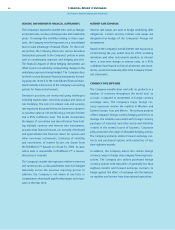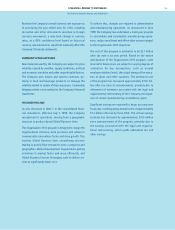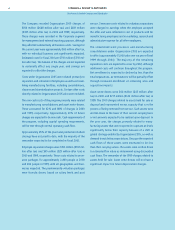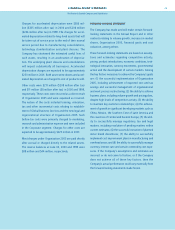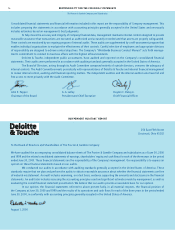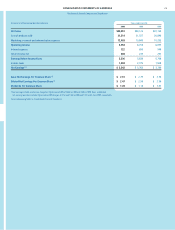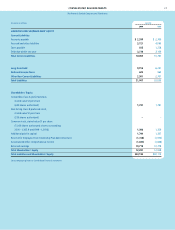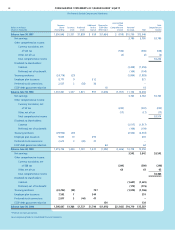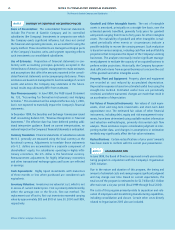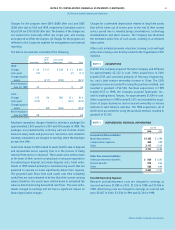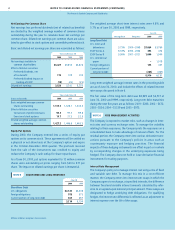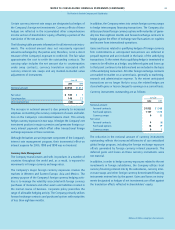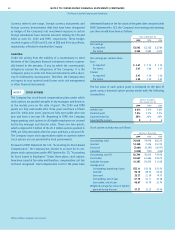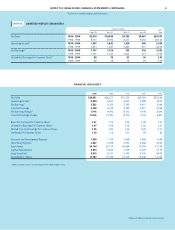Proctor and Gamble 2000 Annual Report Download - page 32
Download and view the complete annual report
Please find page 32 of the 2000 Proctor and Gamble annual report below. You can navigate through the pages in the report by either clicking on the pages listed below, or by using the keyword search tool below to find specific information within the annual report.
The Procter & Gamble Company and Subsidiaries
30
Millions of dollars except per share amounts
NOTES TO CONSOLIDATED FINANCIAL STATEMENTS
NOTE 1 SUMMARY OF SIGNIFICANT ACCOUNTING POLICIES
Basis of Presentation: The consolidated financial statements
include The Procter & Gamble Company and its controlled
subsidiaries (the Company). Investments in companies over which
the Company exerts significant influence, but does not control
the financial and operating decisions, are accounted for using the
equity method. These investments are managed as integral parts
of the Company’s business units, and segment reporting reflects
such investments as consolidated subsidiaries.
Use of Estimates: Preparation of financial statements in con-
formity with accounting principles generally accepted in the
United States of America requires management to make estimates
and assumptions that affect the amounts reported in the consoli-
dated financial statements and accompanying disclosures. These
estimates are based on management’s best knowledge of current
events and actions the Company may undertake in the future.
Actual results may ultimately differ from estimates.
New Pronouncements: In June 1998, the FASB issued Statement
No. 133, “Accounting for Derivative Instruments and Hedging
Activities.” This statement will be adopted effective July 1, 2000,
but is not expected to materially impact the Company’s financial
statements.
In December 1999, the Securities and Exchange Commission issued
Staff Accounting Bulletin 101, “Revenue Recognition in Financial
Statements.” The effective date has been deferred pending addi-
tional interpretive guidance. Based on current interpretations, no
material impact on the Company’s financial statements is anticipated.
Currency Translation: Financial statements of subsidiaries outside
the U.S. generally are measured using the local currency as the
functional currency. Adjustments to translate those statements
into U.S. dollars are accumulated in a separate component of
shareholders’ equity. For subsidiaries operating in highly infla-
tionary economies, the U.S. dollar is the functional currency.
Remeasurement adjustments for highly inflationary economies
and other transactional exchange gains and losses are reflected
in earnings.
Cash Equivalents: Highly liquid investments with maturities
of three months or less when purchased are considered cash
equivalents.
Inventory Valuation: Inventories are valued at cost, which is not
in excess of current market price. Cost is primarily determined by
either the average cost or the first-in, first-out method. The
replacement cost of last-in, first-out inventories exceeded carrying
value by approximately $83 and $100 at June 30, 2000 and 1999,
respectively.
Goodwill and Other Intangible Assets: The cost of intangible
assets is amortized, principally on a straight-line basis, over the
estimated periods benefited, generally forty years for goodwill
and periods ranging from three to forty years for other intangible
assets. The realizability of goodwill and other intangibles is eval-
uated periodically when events or circumstances indicate a
possible inability to recover the carrying amount. Such evaluation
is based on various analyses, including cash flow and profitability
projections that incorporate the impact of the Company’s existing
businesses. The analyses necessarily involve significant manage-
ment judgment to evaluate the capacity of an acquired business to
perform within projections. Historically, the Company has gener-
ated sufficient returns from acquired businesses to recover the cost
of the goodwill and other intangible assets.
Property, Plant and Equipment: Property, plant and equipment
are recorded at cost reduced by accumulated depreciation.
Depreciation expense is based on estimated useful lives using the
straight-line method. Estimated useful lives are periodically
reviewed, and where warranted, changes are made that result in
an acceleration of depreciation.
Fair Values of Financial Instruments: Fair values of cash equiv-
alents, short and long-term investments and short-term debt
approximate cost. The estimated fair values of other financial
instruments, including debt, equity and risk management instru-
ments, have been determined using available market information
and valuation methodologies, primarily discounted cash flow
analysis. These estimates require considerable judgment in inter-
preting market data, and changes in assumptions or estimation
methods may significantly affect the fair value estimates.
Reclassifications: Certain reclassifications of prior years’ amounts
have been made to conform with the current year presentation.
NOTE 2 ORGANIZATION 2005
In June 1999, the Board of Directors approved a multi-year restruc-
turing program in conjunction with the Company’s Organization
2005 initiative.
Due to the nature and duration of this program, the timing and
amount of estimated costs and savings require significant judgment
and may change over time. Based on current expectations, the
total cost of the program is estimated to be $2.7 billion ($2.1 billion
after tax) over a six year period (fiscal 1999 through fiscal 2004).
The costs of this program primarily relate to separation and relo-
cation of employees and streamlining manufacturing capabilities,
including consolidation and closure. Certain other costs directly
related to Organization 2005 also are included.


